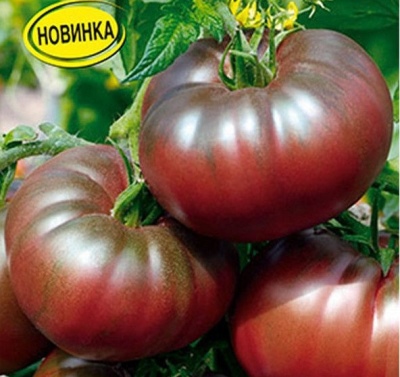
- Category: hybrid
- Growth type: indeterminate
- Appointment: fresh consumption
- Ripening period: mid-season
- Ripening time, days: 110-115
- Growing conditions: for open ground, for greenhouses
- Bush size: tall
- Bush height, cm: up to 200
- Ripe fruit color: chocolate
- Fruit shape: flat-round
Panthers are formidable predators, everyone knows that. However, such a name for a plant variety sounds romantic. And therefore, it is extremely important to understand its features and growing methods.
Description of the variety
Black Panther is a classic tomato hybrid. Therefore, getting a harvest using self-collected seeds will not work. The plant has an indeterminate developmental dynamics. Its bushes rise up to 2 m. Growth normalization plays a very important role.
The main qualities of the fruit
Unusually, the Black Panther berries are chocolate-colored. Their usual weight is 150-200 g. Typical flat-round geometric shape (like many other varieties).
Taste characteristics
The cherry pulp of this tomato is delicious. Its sugar-acid index can range from 6 to 7 units. An expressive pleasant sweetness is noted. And also in the reviews they pay attention to the "caramel" flavor.
Ripening and fruiting
The black panther is a mid-season crop. Normally, the harvest ripens 110-115 days after the release of green shoots. But this indicator can be influenced by both weather conditions and field work. Berry picking is possible:
in July;
in August;
in September.
Yield
Seed germination, according to third-party sources, reaches 91%. In official sources, the level of productivity is not described. According to some third-party materials, it reaches 8 kg per 1 sq. m. Of course, such a result is achievable only under favorable conditions and with impeccable agricultural technology.
The timing of planting seedlings and planting in the ground
It is necessary to sow seeds in a container in the first half of March. Specific days are chosen purely at personal discretion. The readiness of seedlings for planting in open ground is achieved from May 15 to June 5. It should be assessed individually. Attention should be paid to both the maturity of the tomatoes and the likelihood of frost return.

Growing tomato seedlings is an extremely important process, because it largely depends on whether the gardener can harvest at all. All aspects must be taken into account, from seedbed preparation to planting in the ground.
Landing scheme
Mostly these tomatoes are planted in a 600x500 mm system. There is no reason to look for other approaches. You can plant 3 or 4 plants per m2. If possible, you should choose a less dense landing pattern.

Growing and care
Black panther definitely needs to remove stepchildren. Without this, her bushes cannot develop normally. And also prerequisites for success will be tying to supports and forming bushes. Lead them most justifiably in 1 or 2 stems.In the first case, the size of the fruits increases, in the second, there will be slightly more of them.
There is no need to pre-process the seeds. Most often, planting soil is purchased in special stores. However, you can also make it yourself. For this purpose, a combination is used:
humus;
garden land;
peat;
fertilizers.
In any case, the earth must be spilled with a heated fungicide solution. Along with the branded "Fitosporin", you can use permanganate or copper sulfate. Germinate seeds under a film. Seedlings are picked when 1-2 true leaves appear. Watering is recommended in the morning or evening.
Watering the Black Panther must be strictly at the root. It is unacceptable for water to enter the trunk and leaves. After absorbing moisture, it is necessary to loosen the soil. Bushes need to be tied to a support as early as possible. Young specimens are fed with organic substances; in an older age they use:
"Kristalon";
Kemiru-Lux;
Agricola.




A plant needs different micronutrients at each stage of growth. All fertilizers can be divided into two groups: mineral and organic. Folk remedies are often used: iodine, yeast, bird droppings, eggshells.
It is important to observe the rate and period of feeding. This also applies to folk remedies and organic fertilizers.


Review overview
Many gardeners fear that such a crop is too exotic and will create problems for growing. However, in reality, no special difficulties arise. Care is not much different from caring for the planting of other tomatoes. Fruit cracking and other imperfections are uncommon for Black Panthers.

























































































